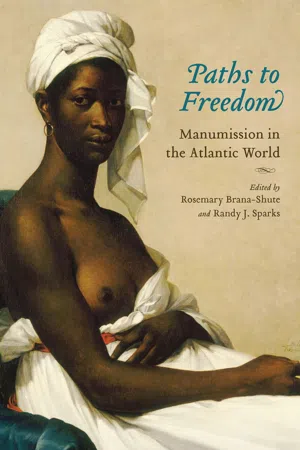
Carolina Lowcountry and the Atlantic World
Manumission in the Atlantic World
- 408 pages
- English
- PDF
- Available on iOS & Android
Carolina Lowcountry and the Atlantic World
Manumission in the Atlantic World
About This Book
An international comparative study of a mode of emancipation that worked to reinforce the institution of slavery
Manumission—the act of freeing a slave while the institution of slavery continues—has received relatively little scholarly attention as compared to other aspects of slavery and emancipation. To address this gap, editors Rosemary Brana-Shute and Randy J. Sparks present a volume of essays that comprise the first-ever comparative study of manumission as it affected slave systems on both sides of the Atlantic.
In this landmark volume, an international group of scholars consider the history and implications of manumission from the medieval period to the late nineteenth century as the phenomenon manifested itself in the Old World and the New. The contributors demonstrate that although the means of manumission varied greatly across the Atlantic world, in every instance the act served to reinforce the sovereign power structures inherent in the institution of slavery. In some societies only a master had the authority to manumit slaves, while in others the state might grant freedom or it might be purchased. Regardless of the source of manumission, the result was viewed by its society as a benevolent act intended to bind the freed slave to his or her former master through gratitude if no longer through direct ownership. The possibility of manumission worked to inspire faithful servitude among slaves while simultaneously solidifying the legitimacy of their ownership.
The essayists compare the legacy of manumission in medieval Europe; the Jewish communities of Levant, Europe, and the New World; the Dutch, French, and British colonies; and the antebellum United States, while exploring wider patterns that extended beyond a single location or era. They also document the fates of manumitted slaves, some of whom were accepted into freed segments of their societies; while others were expected to vacate their former communities entirely. The contributors investigate the cultural consequences of manumission as well as the changing economic conditions that limited the practice by the eighteenth century to understand better the social implications of this multifaceted aspect of the system of slavery.
Frequently asked questions
Information
Table of contents
- Cover
- Paths to Freedom
- Title
- Copyright
- Contents
- Editors’ Note
- Introduction
- Three Notes of Freedom: The Nature and Consequences of Manumission
- Manumission in Metropolitan Spain and the Canaries in the Fifteenth and Sixteenth Centuries
- The Promise of Freedom in Late Medieval Valencia
- Transformations in the Manumission of Slaves by Jews from East to West: Pressures from the Atlantic Slave Trade
- Manumission and the Life Cycle of a Contained Population: The VOC Lodge Slaves at the Cape of Good Hope, 1680–1730
- Paths to Freedom: Imperial Defense and Manumission in Havana, 1762–1800
- How Free Is Free? The Limits of Manumission for Enslaved Africans in Eighteenth-Century British West Indian Sugar Society
- Manumission in an Entrepôt: The Case of Curaçao
- Sex and Gender in Surinamese Manumissions
- Child Abandonment and Foster Care in Colonial Brazil: Expostos and the Free Population of African Descent in Eighteenth-Century Minas Gerais
- Manumission, Gender, and the Law in Nineteenth-Century Brazil: Liberata’s Legal Suit for Freedom
- Conflicts over the Meanings of Freedom: The Liberated Africans’ Struggle for Final Emancipation in Brazil, 1840s–1860s
- From “No Country!” to “Our Country!”Living Out Manumission and the Boundaries of Rights and Citizenship, 1773–1855
- “If the rest stay, I will stay; if they go, I will go”: How Slaves’ Familial Bonds Affected American Colonization Society Manumissions
- Manumission and the Two-Race System in Early National Virginia
- The Slave Owner’s Family and Manumission in the Post-Revolutionary Chesapeake Tidewater: Evidence from Anne Arundel County Wills, 1790–1820
- Liberation in a Rural Context: The Valley of Virginia, 1800–1860
- Contributors
- Index